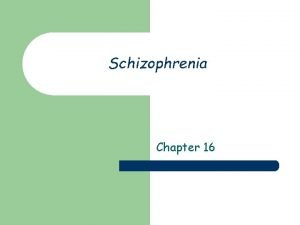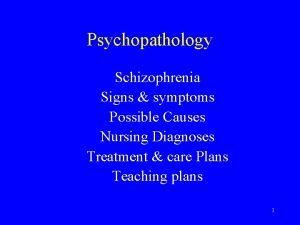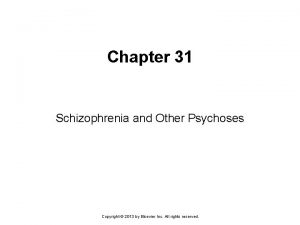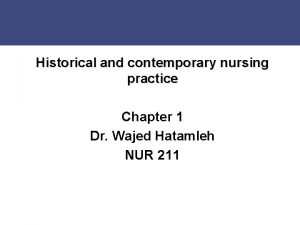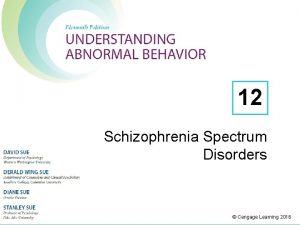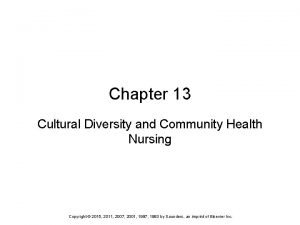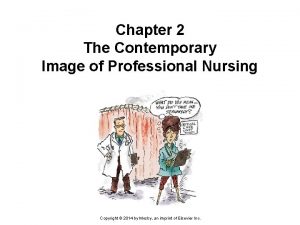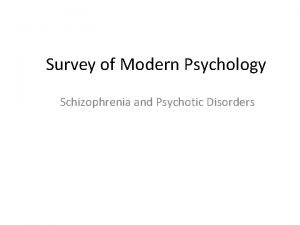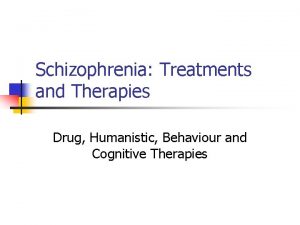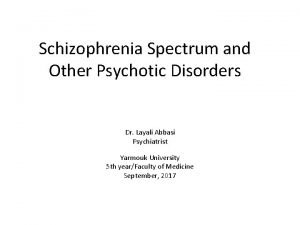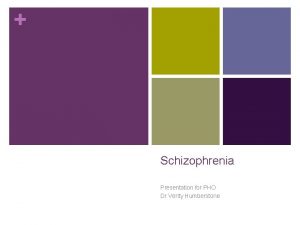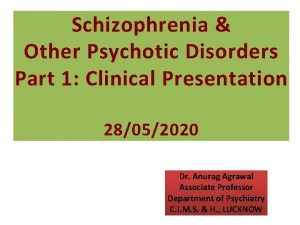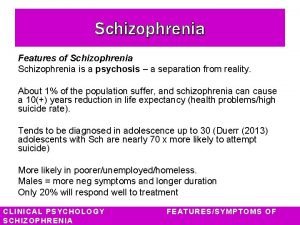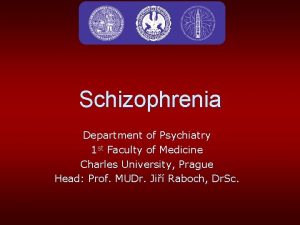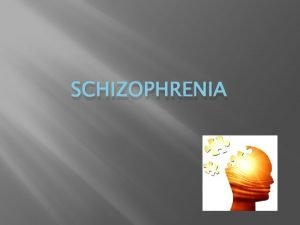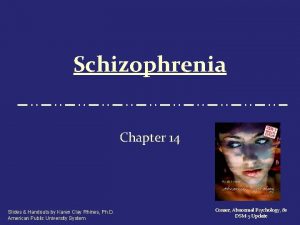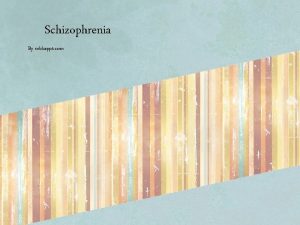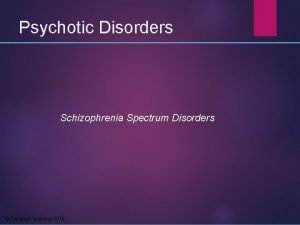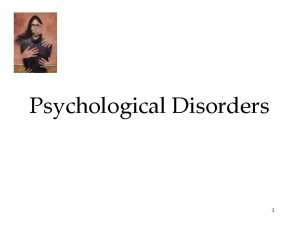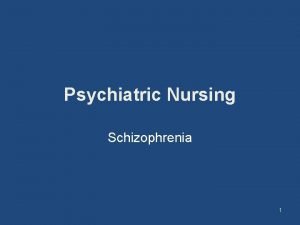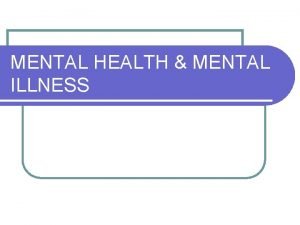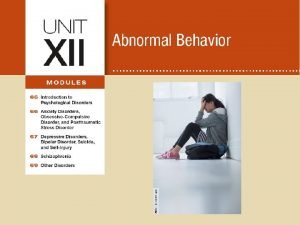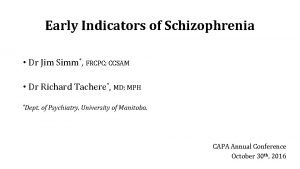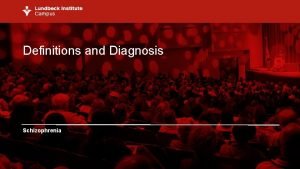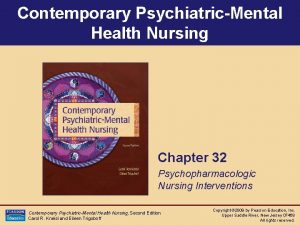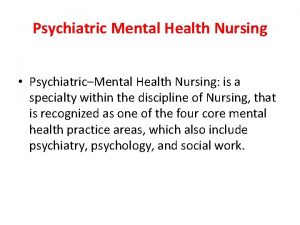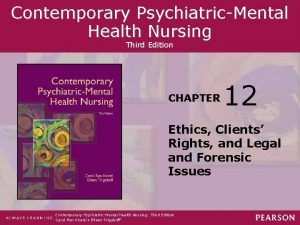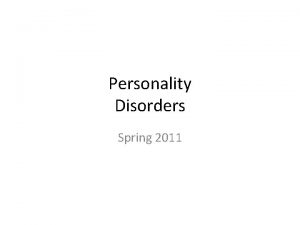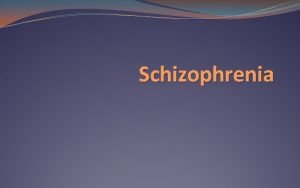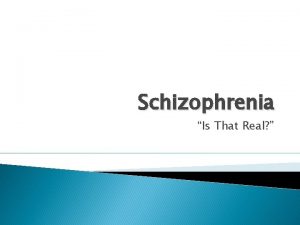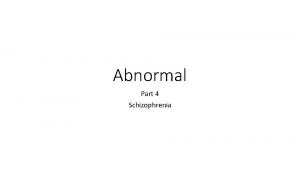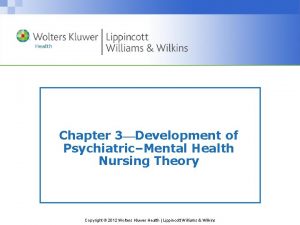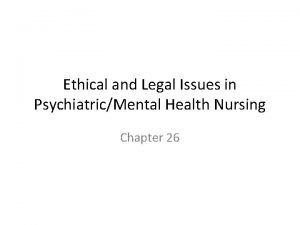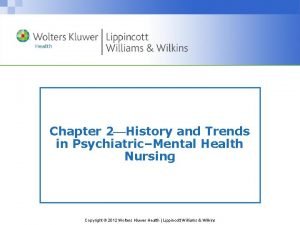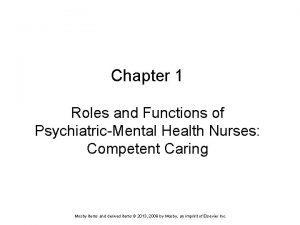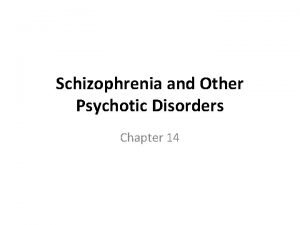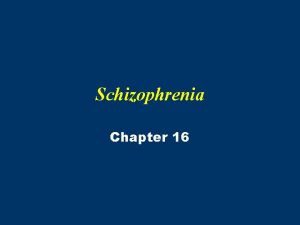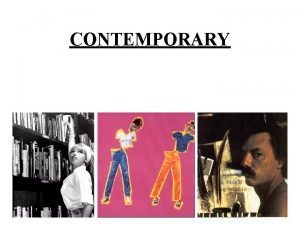Contemporary PsychiatricMental Health Nursing Chapter 16 Schizophrenia and









































- Slides: 41

Contemporary Psychiatric-Mental Health Nursing Chapter 16 Schizophrenia and Other Psychotic Disorders Contemporary Psychiatric-Mental Health Nursing, Second Edition Carol R. Kneisl and Eileen Trigoboff Copyright © 2009 by Pearson Education, Inc. Upper Saddle River, New Jersey 07458 All rights reserved.

Features of Schizophrenia = Prevalence in U. S. is 1. 1%. = Average onset is late teens to early twenties, but can be as late as mid-fifties = Affects cognitive, emotional, and behavioral function = 30% to 40% relapse rate in the first year Contemporary Psychiatric-Mental Health Nursing, Second Edition Carol R. Kneisl and Eileen Trigoboff Copyright © 2009 by Pearson Education, Inc. Upper Saddle River, New Jersey 07458 All rights reserved.

Features of Schizophrenia continued = Progression varies from one client to another – Exacerbations and remissions – Chronic but stable – Progressive deterioration Contemporary Psychiatric-Mental Health Nursing, Second Edition Carol R. Kneisl and Eileen Trigoboff Copyright © 2009 by Pearson Education, Inc. Upper Saddle River, New Jersey 07458 All rights reserved.

Features of Schizophrenia continued = DSM-IV-TR Diagnosis – Symptoms present at least 6 months – Active-phase symptoms present at least 1 month – Symptoms are defined as positive and negative Contemporary Psychiatric-Mental Health Nursing, Second Edition Carol R. Kneisl and Eileen Trigoboff Copyright © 2009 by Pearson Education, Inc. Upper Saddle River, New Jersey 07458 All rights reserved.

Features of Schizophrenia continued = Positive symptoms – Excess or distortion of normal functioning – Aberrant response = Negative symptoms – Deficit in functioning Contemporary Psychiatric-Mental Health Nursing, Second Edition Carol R. Kneisl and Eileen Trigoboff Copyright © 2009 by Pearson Education, Inc. Upper Saddle River, New Jersey 07458 All rights reserved.

Features of Schizophrenia continued = Positive Symptoms of Schizophrenia – Hallucination – Delusions – Disordered speech and behavior Contemporary Psychiatric-Mental Health Nursing, Second Edition Carol R. Kneisl and Eileen Trigoboff Copyright © 2009 by Pearson Education, Inc. Upper Saddle River, New Jersey 07458 All rights reserved.

Features of Schizophrenia continued = Negative Symptoms of Schizophrenia – Flat affect and apathy – Alogia – Avolition – Anhedonia Contemporary Psychiatric-Mental Health Nursing, Second Edition Carol R. Kneisl and Eileen Trigoboff Copyright © 2009 by Pearson Education, Inc. Upper Saddle River, New Jersey 07458 All rights reserved.

Subtypes of Schizophrenia = Paranoid type = Disorganized type = Catatonic type = Undifferentiated type = Residual Type Contemporary Psychiatric-Mental Health Nursing, Second Edition Carol R. Kneisl and Eileen Trigoboff Copyright © 2009 by Pearson Education, Inc. Upper Saddle River, New Jersey 07458 All rights reserved.

Subtypes of Schizophrenia continued = Paranoid Type – Delusions =Persecutory and grandiose =Somatic or religious – Hallucinations =Delusions link with a hallucination Contemporary Psychiatric-Mental Health Nursing, Second Edition Carol R. Kneisl and Eileen Trigoboff Copyright © 2009 by Pearson Education, Inc. Upper Saddle River, New Jersey 07458 All rights reserved.

Subtypes of Schizophrenia continued Click here to view a video featuring Larry, who has been diagnosed as having paranoid schizophrenia. Contemporary Psychiatric-Mental Health Nursing, Second Edition Carol R. Kneisl and Eileen Trigoboff Copyright © 2009 by Pearson Education, Inc. Upper Saddle River, New Jersey 07458 All rights reserved.

Subtypes of Schizophrenia continued = Disorganized type – Disorganized speech, behavior, appearance – Flat or inappropriate affect – Fragmented hallucinations and delusions – Most severe form of schizophrenia Contemporary Psychiatric-Mental Health Nursing, Second Edition Carol R. Kneisl and Eileen Trigoboff Copyright © 2009 by Pearson Education, Inc. Upper Saddle River, New Jersey 07458 All rights reserved.

Subtypes of Schizophrenia continued = Catatonic type – Psychomotor retardation and stupor – Extreme psychomotor agitation – Waxy flexibility – Echolalia – Mutism – Echopraxia Contemporary Psychiatric-Mental Health Nursing, Second Edition Carol R. Kneisl and Eileen Trigoboff Copyright © 2009 by Pearson Education, Inc. Upper Saddle River, New Jersey 07458 All rights reserved.

Subtypes of Schizophrenia continued = Undifferentiated type – Active psychotic state – Lacks symptoms of other subtypes = Residual type – At least one episode of schizophrenia – No prominent positive symptoms – Negative symptoms present Contemporary Psychiatric-Mental Health Nursing, Second Edition Carol R. Kneisl and Eileen Trigoboff Copyright © 2009 by Pearson Education, Inc. Upper Saddle River, New Jersey 07458 All rights reserved.

Other Psychotic Disorders = Schizophreniform disorder = Schizoaffective disorder = Delusional disorder = Brief psychotic disorder Contemporary Psychiatric-Mental Health Nursing, Second Edition Carol R. Kneisl and Eileen Trigoboff Copyright © 2009 by Pearson Education, Inc. Upper Saddle River, New Jersey 07458 All rights reserved.

Causes of Schizophrenia = Biopsychosocial theories = Interrelated factors Contemporary Psychiatric-Mental Health Nursing, Second Edition Carol R. Kneisl and Eileen Trigoboff Copyright © 2009 by Pearson Education, Inc. Upper Saddle River, New Jersey 07458 All rights reserved.

Causes of Schizophrenia - continued = Biologic theories = Psychological theories = Family theories = Humanistic-interactional theories Contemporary Psychiatric-Mental Health Nursing, Second Edition Carol R. Kneisl and Eileen Trigoboff Copyright © 2009 by Pearson Education, Inc. Upper Saddle River, New Jersey 07458 All rights reserved.

Causes of Schizophrenia = Biologic Theory: Genetic – Only genetic predisposition for developing schizophrenia is inherited – 10% of first-degree relatives – 25%-39% of monozygotic twins Contemporary Psychiatric-Mental Health Nursing, Second Edition Carol R. Kneisl and Eileen Trigoboff Copyright © 2009 by Pearson Education, Inc. Upper Saddle River, New Jersey 07458 All rights reserved.

Causes of Schizophrenia - continued = Biologic Theory: Brain Structure Abnormality – Differs from those with no symptoms – May be genetically based – Requires more study Contemporary Psychiatric-Mental Health Nursing, Second Edition Carol R. Kneisl and Eileen Trigoboff Copyright © 2009 by Pearson Education, Inc. Upper Saddle River, New Jersey 07458 All rights reserved.

Causes of Schizophrenia Figure 16. 2 Schizophrenia scans. PET scans of discordant monozygotic twins taken during a test to provoke activity and measure regional cerebral blood flow. (A) Arrows indicate areas of normal blood flow and brain activity in the unaffected twin. (B) Arrows indicate areas of lower blood flow and brain activity in the twin with schizophrenia. Source: Courtesy of Dr. Karen F. Berman, Clinical Brain Disorders Branch, National Institute of Mental Health Contemporary Psychiatric-Mental Health Nursing, Second Edition Carol R. Kneisl and Eileen Trigoboff Copyright © 2009 by Pearson Education, Inc. Upper Saddle River, New Jersey 07458 All rights reserved.

Causes of Schizophrenia - continued = Biologic Theory: Biochemical Theories – Dopamine hypothesis – Traditional antipsychotic medications are dopamine blockers – Dopamine blocker alleviate positive symptoms Contemporary Psychiatric-Mental Health Nursing, Second Edition Carol R. Kneisl and Eileen Trigoboff Copyright © 2009 by Pearson Education, Inc. Upper Saddle River, New Jersey 07458 All rights reserved.

Causes of Schizophrenia - continued = Psychological theories – Information processing =Difficulty controlling the amount and type of information that is processed in the brain. – Attention and arousal =Hyper or hypo responsiveness to various situations Contemporary Psychiatric-Mental Health Nursing, Second Edition Carol R. Kneisl and Eileen Trigoboff Copyright © 2009 by Pearson Education, Inc. Upper Saddle River, New Jersey 07458 All rights reserved.

Causes of Schizophrenia - continued = Psychological theories – Information processing =Deficient in automatic processing =Deficient in controlled or effortful processing – Attention and arousal =Hypo-, hyper-responses Contemporary Psychiatric-Mental Health Nursing, Second Edition Carol R. Kneisl and Eileen Trigoboff Copyright © 2009 by Pearson Education, Inc. Upper Saddle River, New Jersey 07458 All rights reserved.

Causes of Schizophrenia - continued = Family Theories – Dysfunctional interaction not supported by research – Disordered family communication linked only with genetic predisposition – Family emotional tone influences course of schizophrenia – Expressed emotions theory (EE) Contemporary Psychiatric-Mental Health Nursing, Second Edition Carol R. Kneisl and Eileen Trigoboff Copyright © 2009 by Pearson Education, Inc. Upper Saddle River, New Jersey 07458 All rights reserved.

Causes of Schizophrenia - continued = Humanistic-interactional theories integrate biological and psychosocial theories = Combine influences of: – Genetic predisposition or biologic vulnerability – Environmental stressors – Social support Contemporary Psychiatric-Mental Health Nursing, Second Edition Carol R. Kneisl and Eileen Trigoboff Copyright © 2009 by Pearson Education, Inc. Upper Saddle River, New Jersey 07458 All rights reserved.

Causes of Schizophrenia - continued = Stress–Vulnerability Model – Stressors increase vulnerability – Cumulative effect of: =Genetic predisposition =Personal stressors =Familial factors =Environmental factors Contemporary Psychiatric-Mental Health Nursing, Second Edition Carol R. Kneisl and Eileen Trigoboff Copyright © 2009 by Pearson Education, Inc. Upper Saddle River, New Jersey 07458 All rights reserved.

Influences on the Course of Schizophrenia = Social Pressures – Lack of social support – Financial problems – Stigma Contemporary Psychiatric-Mental Health Nursing, Second Edition Carol R. Kneisl and Eileen Trigoboff Copyright © 2009 by Pearson Education, Inc. Upper Saddle River, New Jersey 07458 All rights reserved.

Influences on the Course of Schizophrenia - continued = Psychological pressures – Difficulty with problem-solving – Difficulty with interpreting reality – Difficulty coping – Problems with self-care – Unstable interpersonal relationships Contemporary Psychiatric-Mental Health Nursing, Second Edition Carol R. Kneisl and Eileen Trigoboff Copyright © 2009 by Pearson Education, Inc. Upper Saddle River, New Jersey 07458 All rights reserved.

Nursing Implications = Assessment – Premorbid functioning – Content of thought – Form of thought – Perception – Sense of self – Delusions and perceptual disturbances – Hallucinations – Drug use Contemporary Psychiatric-Mental Health Nursing, Second Edition Carol R. Kneisl and Eileen Trigoboff Copyright © 2009 by Pearson Education, Inc. Upper Saddle River, New Jersey 07458 All rights reserved.

Nursing Implications - continued = Nursing Diagnoses – Altered thought process – Social isolation – Risk for violence – Self-care deficits – Altered health maintenance – Ineffective family coping Contemporary Psychiatric-Mental Health Nursing, Second Edition Carol R. Kneisl and Eileen Trigoboff Copyright © 2009 by Pearson Education, Inc. Upper Saddle River, New Jersey 07458 All rights reserved.

Nursing Implications: Supporting Families = Family needs vary with degree of illness and involvement in client’s care – – – Education Financial support Psychosocial support Education Advocacy Contemporary Psychiatric-Mental Health Nursing, Second Edition Carol R. Kneisl and Eileen Trigoboff Copyright © 2009 by Pearson Education, Inc. Upper Saddle River, New Jersey 07458 All rights reserved.

Nursing Implications: Supporting Families - continued = Schizophrenia is a “family illness. ” = Family members need to be involved. = Educate family about – Medication – Illness – Relapse prevention = Nurse assists family by – Identifying community agencies/groups for family members – Advocating for rights Contemporary Psychiatric-Mental Health Nursing, Second Edition Carol R. Kneisl and Eileen Trigoboff Copyright © 2009 by Pearson Education, Inc. Upper Saddle River, New Jersey 07458 All rights reserved.

Measures to Prevent Relapse = Ensure client takes medication = Educate family about signs and symptoms of relapse = Client and family to participate in relapse prevention program Contemporary Psychiatric-Mental Health Nursing, Second Edition Carol R. Kneisl and Eileen Trigoboff Copyright © 2009 by Pearson Education, Inc. Upper Saddle River, New Jersey 07458 All rights reserved.

Measures to Prevent Relapse continued = Relapse prevention programs work best when: – Psychosocial treatment and social skills training are combined with antipsychotic medication – Behavior patterns are monitored – Family members understand triggers Contemporary Psychiatric-Mental Health Nursing, Second Edition Carol R. Kneisl and Eileen Trigoboff Copyright © 2009 by Pearson Education, Inc. Upper Saddle River, New Jersey 07458 All rights reserved.

Measures to Prevent Relapse continued = Relapse prevention programs provide education and support regarding: – – – Individual triggers, symptoms of relapse Managing side effects of medications Interventions to reduce or eliminate triggers Strategies to facilitate early intervention Cognitive therapy Community resources Contemporary Psychiatric-Mental Health Nursing, Second Edition Carol R. Kneisl and Eileen Trigoboff Copyright © 2009 by Pearson Education, Inc. Upper Saddle River, New Jersey 07458 All rights reserved.

Challenges to Adherence = Side effects = Level of symptomatology = Cognitive, motivational, financial, and cultural issues = Issues with caregivers = Insufficient medication teaching Contemporary Psychiatric-Mental Health Nursing, Second Edition Carol R. Kneisl and Eileen Trigoboff Copyright © 2009 by Pearson Education, Inc. Upper Saddle River, New Jersey 07458 All rights reserved.

Increasing Adherence = Involve clients in treatment = Instruct client about reducing discomfort = Provide peer support = Provide reminders and positive feedback = Recognize accomplishments Contemporary Psychiatric-Mental Health Nursing, Second Edition Carol R. Kneisl and Eileen Trigoboff Copyright © 2009 by Pearson Education, Inc. Upper Saddle River, New Jersey 07458 All rights reserved.

Personal Awareness = Identify personal feelings. = Recognize personal perceptions. = What behaviors do you expect to see? = How will you respond to these behaviors? = What is the meaning of the behaviors? Contemporary Psychiatric-Mental Health Nursing, Second Edition Carol R. Kneisl and Eileen Trigoboff Copyright © 2009 by Pearson Education, Inc. Upper Saddle River, New Jersey 07458 All rights reserved.

Personal Awareness - continued = What defines “normal” behavior? = What are my fears associated with mental illness? Contemporary Psychiatric-Mental Health Nursing, Second Edition Carol R. Kneisl and Eileen Trigoboff Copyright © 2009 by Pearson Education, Inc. Upper Saddle River, New Jersey 07458 All rights reserved.

Personal Awareness - continued = Be honest with your feelings. = Identify what strengths you bring to the situation. = Remember that clients are human beings with a mental disorder and do not choose to be this way. Contemporary Psychiatric-Mental Health Nursing, Second Edition Carol R. Kneisl and Eileen Trigoboff Copyright © 2009 by Pearson Education, Inc. Upper Saddle River, New Jersey 07458 All rights reserved.

Resources = http: //www. nami. org The National Alliance on Mental Illness provides information, education, and support relating to mental health illnesses and disorders for clients, families, and professionals. = http: //www. nimh. nih. gov/health/topics/schizophrenia/index. shtml The National Institute of Mental Health is part of the Department of Health and Human Services and has information about research on various mental health illnesses. = http: //www. nlm. nih. gov/medlineplus/schizophrenia. html Medline Plus is a service of the National Library of Medicine and the National Institutes of Health. This site provides definitions related to various aspects of schizophrenia. Contemporary Psychiatric-Mental Health Nursing, Second Edition Carol R. Kneisl and Eileen Trigoboff Copyright © 2009 by Pearson Education, Inc. Upper Saddle River, New Jersey 07458 All rights reserved.

Resources - continued = http: //www. narsad. org/index. html The National Alliance for Research on Schizophrenia and Depression (NARSAD) is a private, non-for-profit charity organization primarily organized to raise funds for research. = http: //www. mayoclinic. com Search by topic on this Mayo Clinic link to find current information about mental illness Contemporary Psychiatric-Mental Health Nursing, Second Edition Carol R. Kneisl and Eileen Trigoboff Copyright © 2009 by Pearson Education, Inc. Upper Saddle River, New Jersey 07458 All rights reserved.
 Catatonic behavior example
Catatonic behavior example Thought insertion
Thought insertion Chapter 31 schizophrenia and other psychoses
Chapter 31 schizophrenia and other psychoses Nightingale definition of nursing
Nightingale definition of nursing Chapter 12 schizophrenia spectrum disorders
Chapter 12 schizophrenia spectrum disorders Is schizophrenia on a spectrum
Is schizophrenia on a spectrum Culturological assessment
Culturological assessment Contemporary professional nursing
Contemporary professional nursing Chapter 3 health wellness and health disparities
Chapter 3 health wellness and health disparities Chapter 1 lesson 2 what affects your health
Chapter 1 lesson 2 what affects your health Chapter 1 lesson 1 your total health
Chapter 1 lesson 1 your total health What is contemporary health issues
What is contemporary health issues Contemporary health issues class
Contemporary health issues class Define modular nursing in management
Define modular nursing in management Health and social component 3
Health and social component 3 Mse example report
Mse example report Catatonic behavior
Catatonic behavior Signs of schizophrenia in children
Signs of schizophrenia in children Humanistic approach to schizophrenia
Humanistic approach to schizophrenia Schizoaffective disorder
Schizoaffective disorder First-line treatment for schizophrenia
First-line treatment for schizophrenia Bleuler 4a
Bleuler 4a Schizophrenia's literal translation means...
Schizophrenia's literal translation means... Types of delusions
Types of delusions Thesis statement on schizophrenia
Thesis statement on schizophrenia Residual schizophrenia
Residual schizophrenia Hebephrenic schizophrenia
Hebephrenic schizophrenia Disorganized schizophrenia
Disorganized schizophrenia Example of loose associations in schizophrenia
Example of loose associations in schizophrenia Thought insertion
Thought insertion Phases of schizophrenia
Phases of schizophrenia Outline one psychological explanation of schizophrenia
Outline one psychological explanation of schizophrenia Negative explanatory style
Negative explanatory style Double bind example
Double bind example Nursing care plan for hallucination
Nursing care plan for hallucination Example of loose associations in schizophrenia
Example of loose associations in schizophrenia Motivational interviewing schizophrenia
Motivational interviewing schizophrenia Schizophrenia def
Schizophrenia def Module 68 schizophrenia
Module 68 schizophrenia Prevalence of schizophrenia
Prevalence of schizophrenia Complications of schizophrenia
Complications of schizophrenia Reality testing worksheet schizophrenia
Reality testing worksheet schizophrenia
